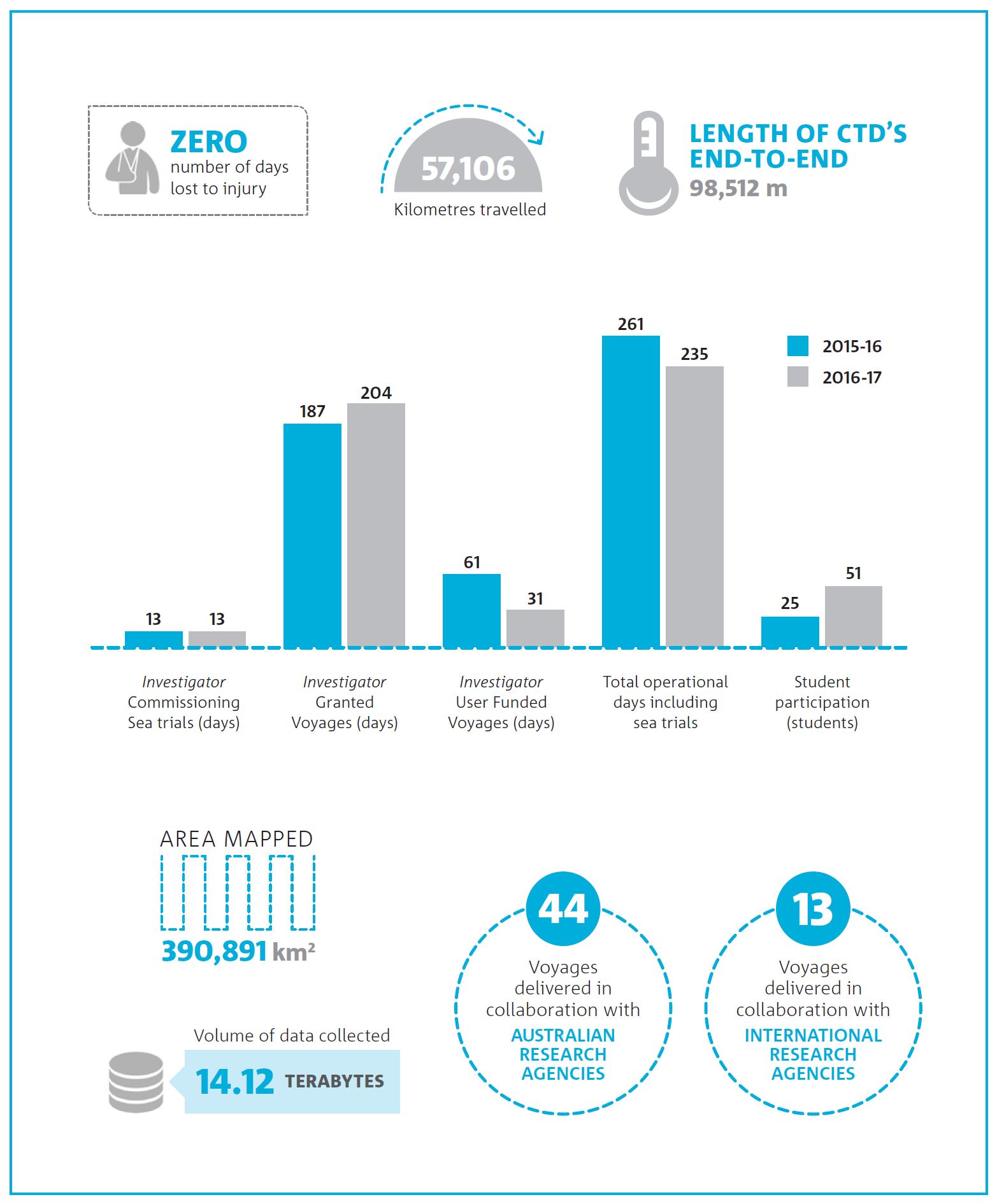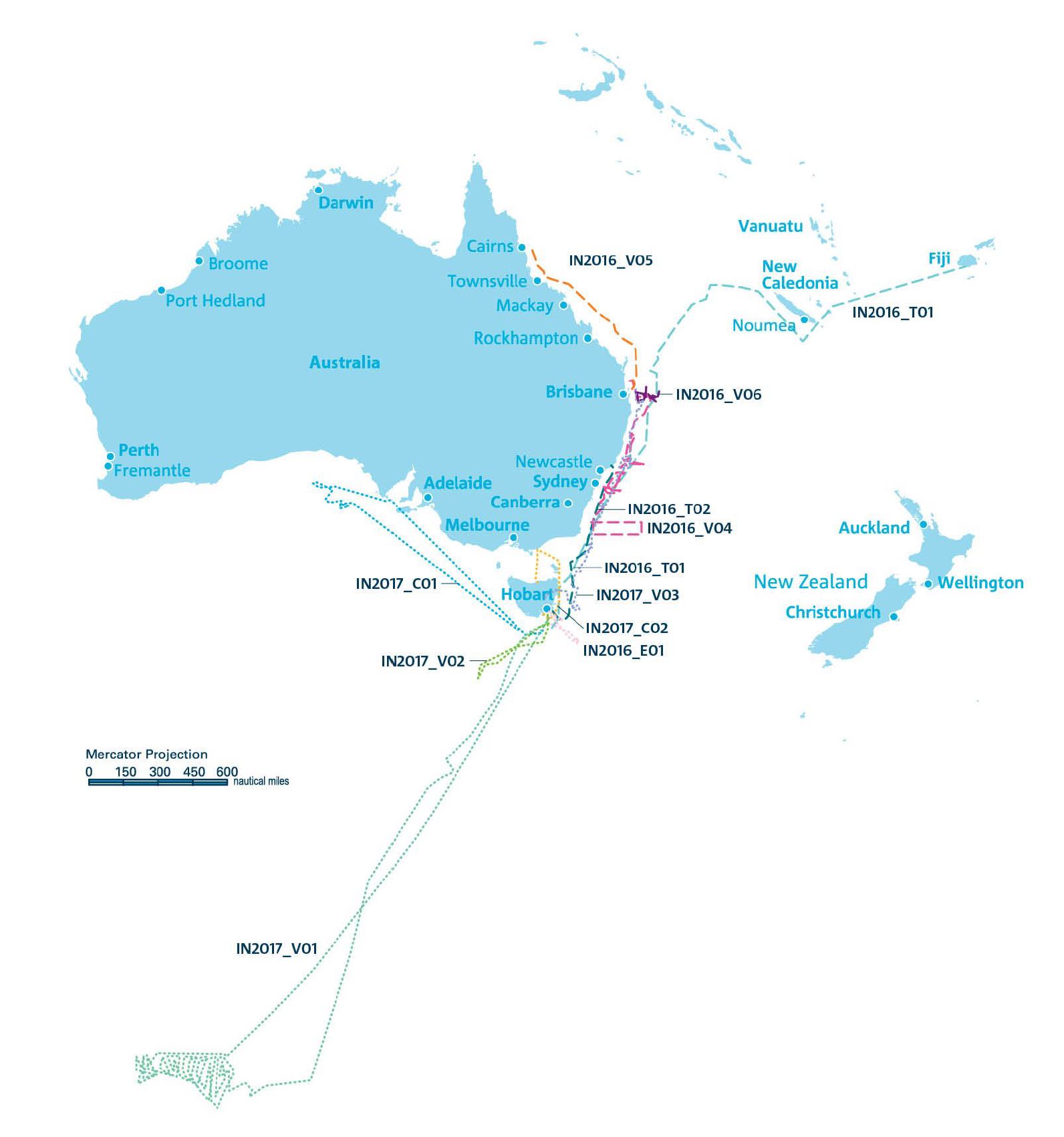Download the Annual Report 2016-17:
Marine National Facility
Annual Report 2016–17
About the Marine National Facility
 The Marine National Facility (MNF) is a national blue-water research facility that has been funded by the Australian Government since 1984. The MNF consists of:
The Marine National Facility (MNF) is a national blue-water research facility that has been funded by the Australian Government since 1984. The MNF consists of:
- the 94 metre blue-water research vessel Investigator;
- an extensive suite of fixed and modular state-of-the-art scientific equipment;
- an active repository of publicly available marine data and samples collected over 30 years; and
- a team of specialist staff to support the MNF and research vessel users.
The Marine National Facility is operated by CSIRO and overseen by an independent Steering Committee. It provides world-class blue-water research capability to the Australian scientific community and their international collaborators for work in Australia’s vast marine estate and beyond. Through merit based grants of sea time, research undertaken through the MNF benefits Australia by providing key information to government, industry and other stakeholders to support evidence-based decision-making towards sustainable development.
Australia has the third largest marine estate globally and the MNF is a keystone element of the nation’s research infrastructure to support the effective management and conservation of this territory. MNF research focuses on challenges such as environmental and fisheries management, geological resources, regional and global climate, coastal and offshore development and maritime heritage. To complement and increase utilisation of MNF capability, user funded voyage applications to undertake research of national benefit, are accepted and awarded sea time.
From the Chairperson
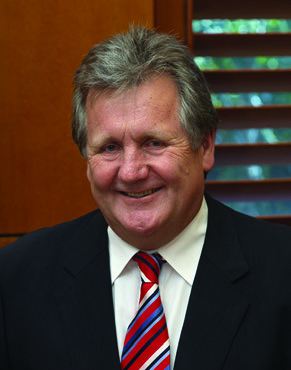
2016–17 saw Investigator deliver its first full year science schedule free of testing voyages required for ship commissioning. From time in Queensland waters studying the relationship between the Great Barrier Reef and climate processes, through to the study of the interaction of the Totten Glacier with the Southern Ocean, Investigator continues to deliver multidisciplinary projects across Australia’s vast ocean territory.
The assessment of applications for sea time is the strategic cornerstone of the MNF, with merit determined on three criteria: scientific excellence, national benefit and track record. The Scientific Advisory Committee (SAC) and the inaugural meeting of the newly created National Benefit Assessment Panel (NBAP) sat in November 2016 to consider single year applications for primary granted voyages for 2018–19. Demand was again strong for the available 180 days with 17 applications requesting a total of 544 days at sea. The approved schedule will see the vessel operating in the Southern Ocean for a large part of the year before travelling back to Western Australia to conduct surveys along Australia's International Indian Ocean Expedition line as part of the second International Indian Ocean Expedition (IIOE2: 2015–2020). As always, applications were of a very high standard, and I take the opportunity to thank all of our applicants for their submissions, the Scientific Advisory Committee (SAC) and National Benefit Assessment Panel (NBAP) for their rigorous review of them and the MNF staff for their oversight of the process and input into finalising the schedule of voyages.
The Steering Committee note, in particular, that the introduction of NBAP has produced greater transparency in assessing the potential national benefit and the path to research impact. The NBAP collectively provides an understanding of end-user needs including a strong working knowledge of Australian marine policy, management and industry priorities, and the associated research priorities.
Working towards achieving full year operations for the Investigator remains the highest priority for the Steering Committee, which continues its focus on seeking increased funding to support the vessel to deliver full capability.
The realisation of Investigator's research schedule over the past 12 months is the result of the commitment and hard work of the MNF Ships Group, technical staff and our ship users. I would like to take this opportunity to thank them for their continued efforts.
A special thanks is reserved for Mr Ron Plaschke, the MNF’s Director for the past five years. During his tenure, Ron oversaw a number of significant changes to the MNF including, most prominently, the successful development and introduction into service of research vessel Investigator, and the installation and commissioning of a broad, multi-million dollar suite of scientific equipment. Investigator’s entry into service has been a resounding success and is a testament to Ron’s expertise and leadership of the diverse team required to support the governance, management and operation of the MNF.
Dr Ian Poiner, Chairperson
MNF Steering Committee
From the Director

With two years of experience operating Investigator there was an internal review of the MNF Ships Group structure in October 2016 to ensure the Group had the required skills and organisational structure to address the challenges identified and lessons learnt. As a result, the MNF Operations Team added new roles to provide additional support in the areas of Health, Safety and Environment, and administration. The support brings additional capacity to successfully deliver voyages safely, and to assist meeting the increased operational requirements resulting from the new vessel's much more complex voyage schedule.
Investigator provides an impressive platform to deliver on the Science, Technology, Engineering and Mathematics (STEM) agenda which is a priority for the MNF, recognising the role graduates in these fields will play as future sea going marine scientists and mariners. To take advantage of this opportunity, the MNF successfully trialled an Educator-on-Board (EoB) program on a voyage to the remote Totten Glacier in East Antarctica in January 2017, providing a berth to high-school teacher Mr Stuart Gifford. Mr Gifford received hands-on experience working with the science team on-board and shared this with classrooms around Australia via live video crosses, giving Australian students the opportunity to experience in real time the research being delivered by Investigator.
Stuart also developed lesson plans for use by educators across the country in the delivery of STEM lessons to students. With the success of the trial, the MNF is developing a framework in collaboration with the CSIRO Education and Outreach team to deliver EoB more regularly. The program provides an opportunity to leverage additional educational benefits from voyages, and for educators to work with marine community users to optimise the use of the platform.
Ms Toni Moate
Director, National Collections and Marine Infrastructure
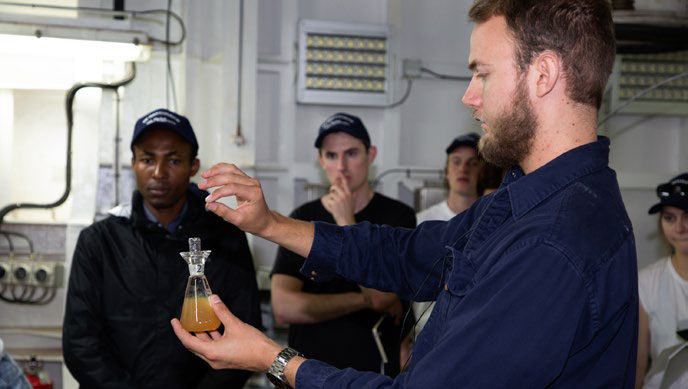
Health, Safety and Environment
Marine operations bring unique challenges in the management of health, safety and the environment. The MNF goal is zero harm and we are continuously seeking opportunities to improve systems, procedures and policies designed to ensure the safety of people on and around Investigator. People are at the heart of the MNF’s ability to deliver great science and innovation to our customers.
The new model of interdisciplinary science voyages spanning atmospheric, oceanographic, biological, geoscience and maritime heritage research and the increased capability to deliver longer voyages to more remote regions with an increased complement of crew and scientists has brought with it new challenges for the MNF with regard to health, safety and the environment. To meet these challenges, the MNF completed a detailed review of its health and safety systems in 2016–17 to ensure that all risks were identified and adequately mitigated. As a result of the review, the MNF introduced a range of new processes and controls to ensure that work conducted on board will cause no harm to people or the environment. In parallel, a number of initiatives were rolled out to MNF personnel to improve incident reporting and reinforce the responsibility of all personnel in the management of safety.
This heightened awareness and improved reporting mechanisms is likely to have led to an increase in reported incidents for the 2016–17 year against those of the previous reporting period. To ensure this is indeed the cause of the observed increase, a newly formed MNF HSE Committee will closely monitor HSE performance over the next 12 months.
No Lost Time Injuries were incurred during the 2016–17 financial year.
| 2015–16 | 2016–17 | |
|---|---|---|
| Lost Time Injury | 0 | 0 |
| Medical Treatment Case | 2 | 4 |
| First Aid Case | 6 | 22 |
| Illness | 2 | 5 |
| Total | 10 | 31 |
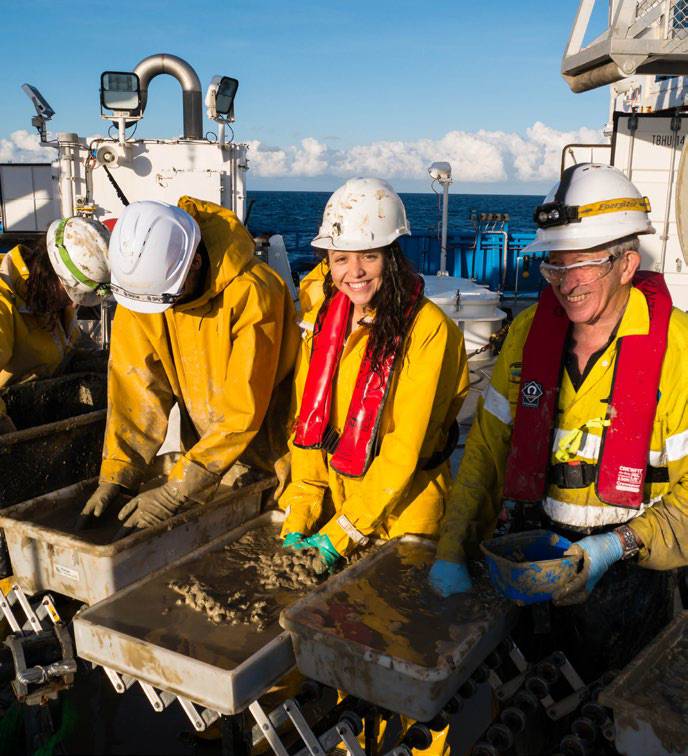
Continuous review and improvement initiatives for Investigator
Winch Inhibition Project
The MNF implemented a Winch Inhibition Project in 2017 to increase the safety for crew and participants involved in the operation of these high risk systems. The winch inhibition system requires that all winches are physically padlocked in the inhibited position by default, with a formal lock-out tag-out procedure followed to activate a winch for use. This initiative now provides an additional physical barrier to protect personnel from accidental winch use when working on scientific equipment.
Highlights
Research schedule
An overview of the MNF voyage schedule for 2016–17 can be found on the MNF website. This includes Voyage Plans, Voyage Summaries and Scientific Highlight reports for each voyage.
The 2016–17 year commenced with the first of three transit voyages for the year as the vessel made its way back from Fiji to its home port of Hobart. A brief sea-trial out of Hobart was delivered to test and calibrate coring and dredging equipment in preparation for primary voyages later in the schedule. The vessel then transited to Sydney for the first of three primary voyages focused along the east coast of Australia to study the East Australia Current and Great Barrier Reef. Following this, the vessel travelled to Garden Island (NSW) for its first drydock since commissioning.
After systems trialing on the journey back to Hobart from Sydney, Investigator embarked on a voyage to the Totten Glacier in East Antarctica at the limit of the ship’s operating envelope. The trip to Antarctica was followed by a return to the Southern Ocean to maintain Integrated Marine Observing System moorings and two user funded voyages: the first being the second voyage for CSIRO Energy in a project with Chevron, and the second building the MNF's relationship with the Australian Hydrographic Service to map discreet areas in Bass Strait over 10 days.
The schedule concluded with a voyage led by Museums Victoria to sample the abyss along Australia's east coast including a number of Commonwealth Marine Reserves.
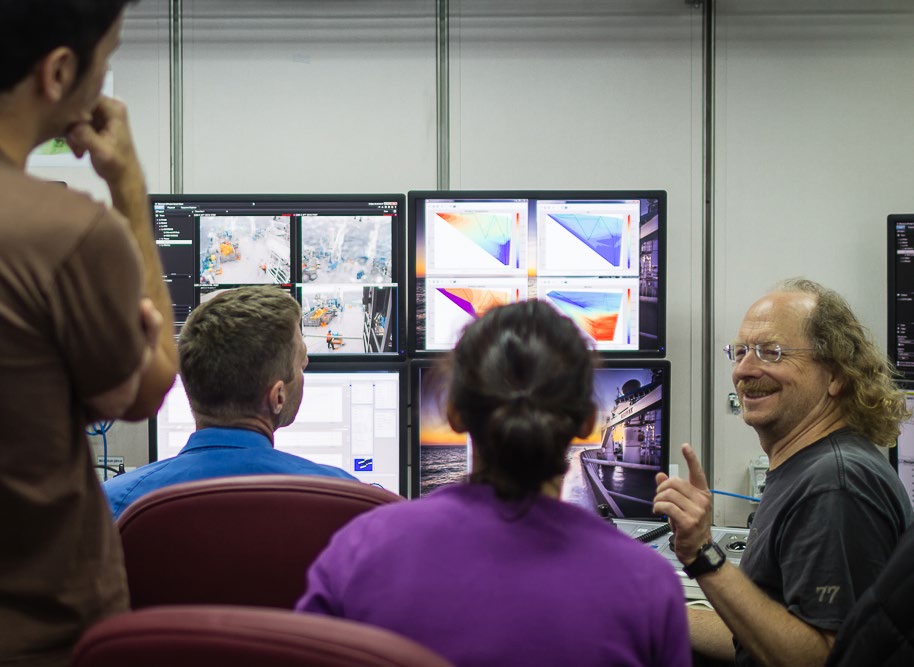
Voyage Spotlight – Delivering a world-first biodiversity survey of the abyss
The marine life at abyssal depths (>4000 m) along Australia’s eastern coastline is little understood. The lack of baseline data about species and their distribution makes it difficult to set policy and measure change. The increase of capability delivered by Investigator has, for the first time, provided the opportunity for researchers to sample at these depths.

In May and June 2017, Museums Victoria led a 31-day voyage on Investigator to conduct the first dedicated survey of marine life and the geophysical features of the abyss from Tasmania to Queensland. The voyage involved 38 scientists and support staff from seven countries and 14 institutions, including CSIRO, Museums Victoria, Australian Museum, Queensland Museum, Tasmanian Museum and Art Gallery, Deakin University and the University of Melbourne.
A broad range of research was undertaken during the voyage using a wide suite of the MNF scientific equipment, including deep water biodiversity sampling using nets, sleds and underwater cameras as well as processing, sampling and analysing specimens recovered using the ship’s on-board laboratory facilities.
During the voyage 42,747 specimens were collected, with over one third of the invertebrates thought to be new species. New vertebrate species will require description and be housed at museums and institutions across Australia, providing future material for research and study.
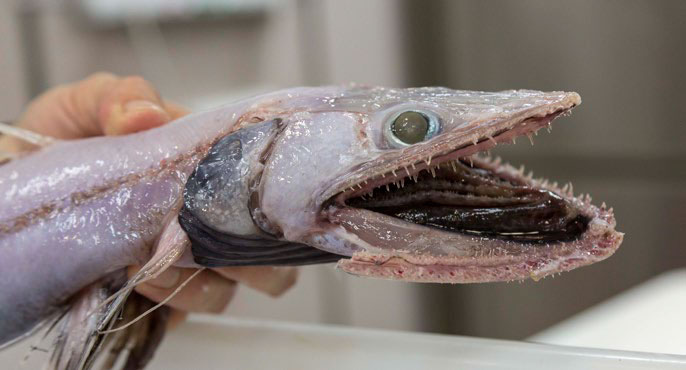
Highly detailed sea floor bathymetry surveys were also completed in seven marine reserves for the managing authority, Parks Australia. Better understanding of these habitats will assist Parks Australia to manage these important but little understood parts of our national marine assets.
The bathymetry voyage also surveyed marine debris and micro-plastics encountered in surface waters and from abyssal depths. This research is only possible due to the space and flexibility that Investigator offers. The information gathered from this project will contribute to better understandings of the impact of human activity on natural environments far removed from cities and homes.
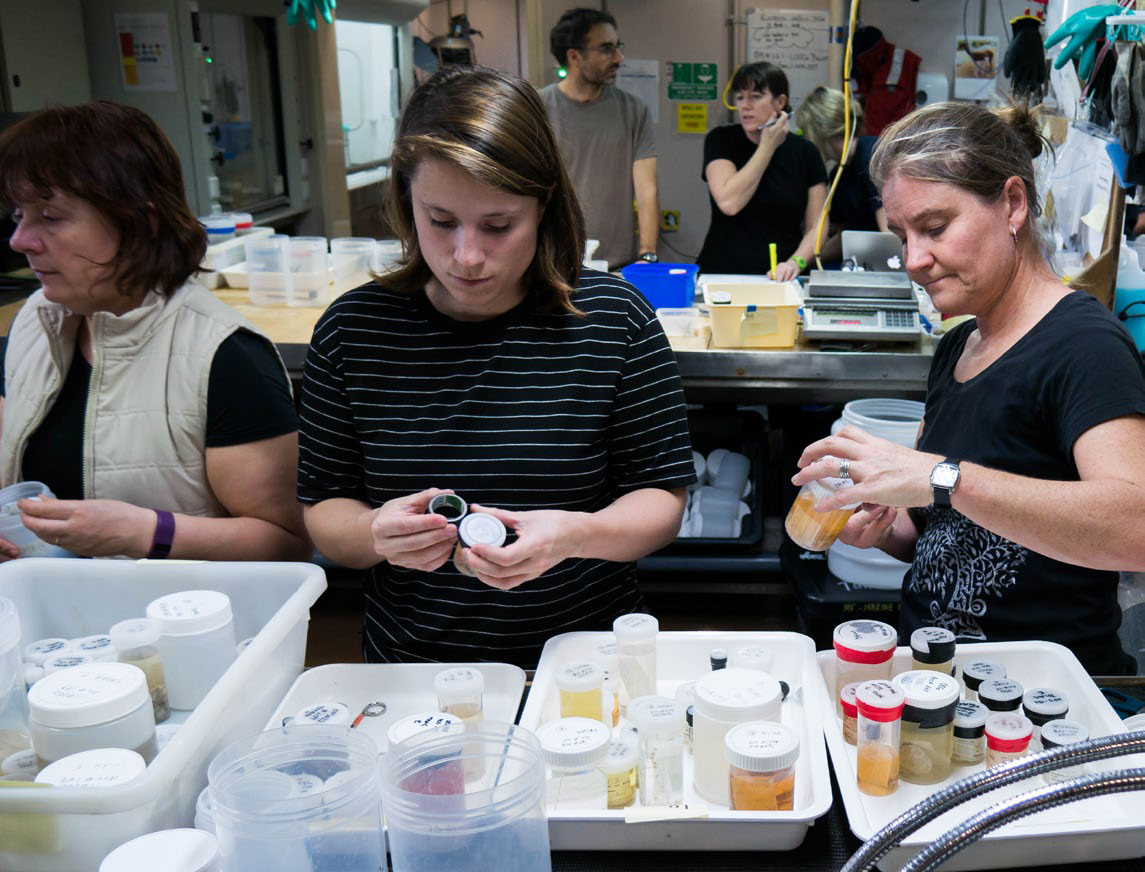
Investigator demonstrates the value of the MNF as an international collaboration hub for knowledge exchange between scientists and end-users and, importantly, between scientists and the public. The significant public interest this voyage generated means that the data collected are already having an impact. Using the ship’s communication and broadcast capabilities, the science and discoveries were shared in the media during the voyage and reached a combined global audience in the millions, increasing awareness of life in our deepest oceans and how human activity can impact on it.
Communicating what we do
Effectively communicating what we do provides an opportunity for the Marine National Facility to demonstrate return on investment to the Australian public.
The MNF is committed to educating the Australian community about the research, education and training we deliver in order to demonstrate return on investment and ensure that decision makers at all levels – from individual citizens to government and industry – are well-informed and continue to support of the Facility into the future.
MNF communications have four strategic objectives:
Objective 1 – promote the MNF as a world-leading marine research capability available for Australian marine researchers
Objective 2 – raise awareness of the value and impact of the research, education and training delivered by the MNF
Objective 3 – effectively manage communication issues in order to protect and enhance the reputation of the MNF
Objective 4 – maintain brand visibility to ensure the MNF is identified as Australia’s blue-water research capability
To achieve these objectives, the MNF collaborates widely with the ship user community to support the regular delivery of communications that are relevant, accessible and appealing. MNF communicators focus on producing high-quality, multimedia communication products that are visually engaging and highlight the impact of the MNF and the need for full year operations for Investigator.
The MNF engages with target audiences through its stakeholder networks, and conventional and social media, as well as via a wide range of direct, digital and print platforms. The MNF also leverages the extensive reach of CSIRO communication channels, including the CSIROscope blog, to tell the story of the science, scientists and ship, and the impact delivered by every voyage.
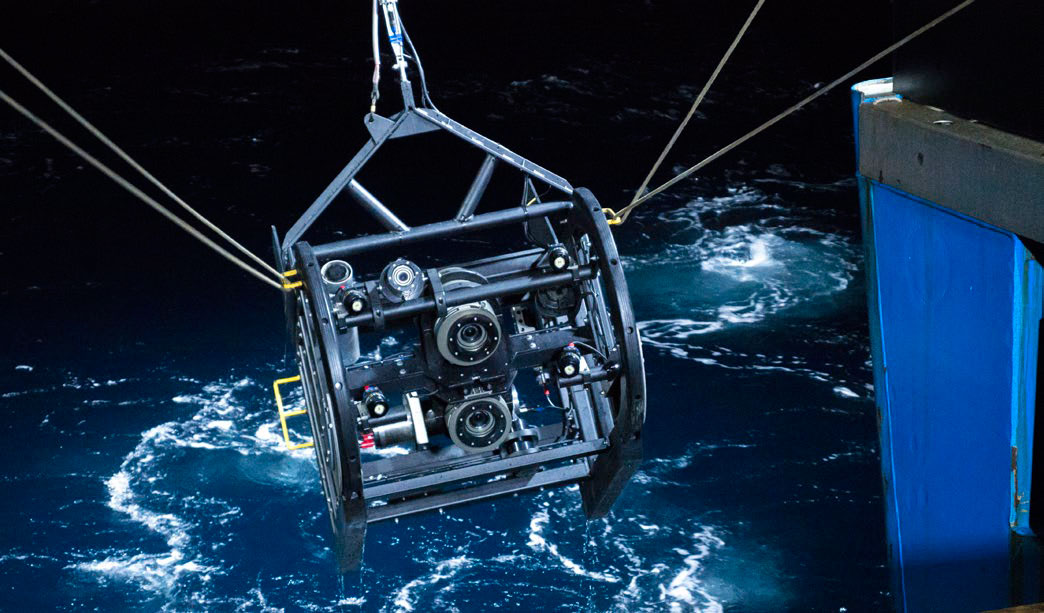
Financial performance
Strong financial management is critical to ensuring the Marine National Facility remains viable, effective, and accountable for the expenditure of public funds.
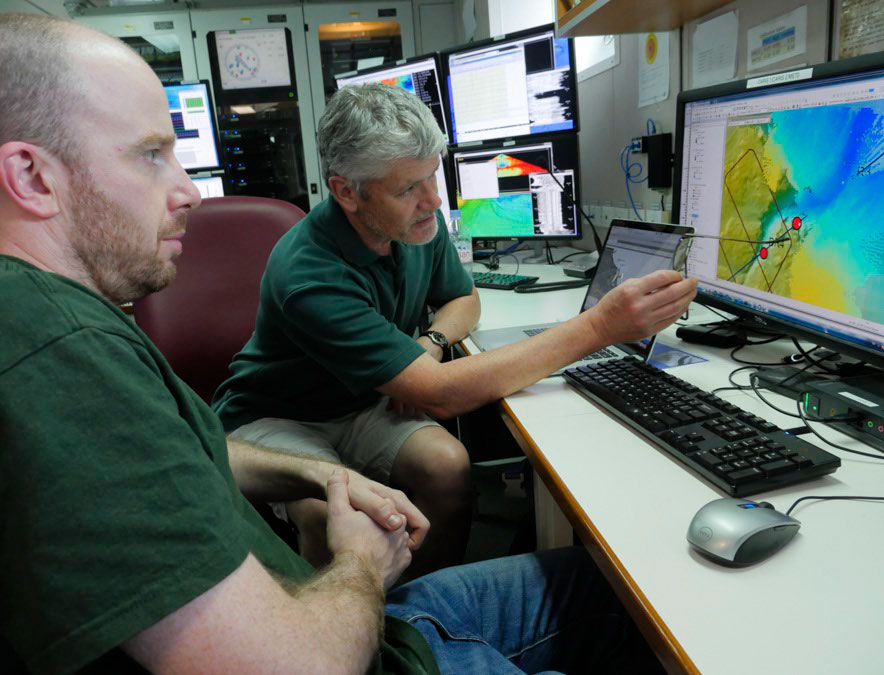
| 2017 | 2016 | ||
|---|---|---|---|
| $'000 | $'000 | ||
| Revenue | |||
| External Funding |
891 |
18 |
|
| Internal Funding | 31,709 | 29,130 | |
| Total Revenue | 32,600 | 29,147 | |
| Expenditure | |||
| Salaries (including Pan-Deployments) | 5,841 | 4,572 | |
| Travel | 323 | 317 | |
| Other Operating | 18,942 | 17,004 | |
| Enterprise costs | 5,649 | 5,742 | |
| Total Expenditure | 30,755 | 27,634 | |
| Operating Result | 1,845 | 1,514 | |
| Capital | |||
| Capital Purchases (excluding FRV) | 712 | 706 | |
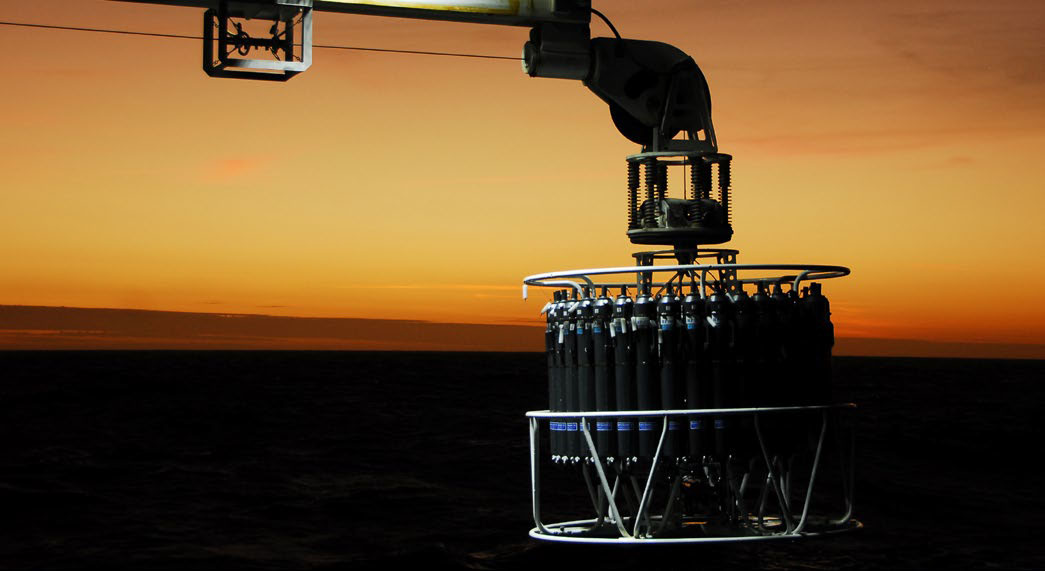
Acquisition of new science equipment and capabilities
Each year, the MNF undertakes a process to identify, prioritise and plan for the acquisition of major items of scientific equipment to support and increase the capability of the vessel for the benefit of users.
This year, the MNF spent $712,000 on science equipment, an overview of which can be reviewed on the MNF website.
Looking to the future
The Marine National Facility seeks to provide the best possible support to Australia’s marine science community and their collaborators. It also strives to increase engagement with future and early career researchers to grow Australia’s role as a global leader in a broad range of ocean science disciplines.
Having completed two years of operations since the commissioning year of RV Investigator further highlights the need for full year operations for the vessel. It is also timely to take a look at what we have learnt so far and apply those lessons to improving the way we support Australia’s marine scientists accessing and working on the vessel.
Planning and managing multidisciplinary research cruises is a complex endeavor and a significant time commitment for already busy scientists. The MNF is committed to continuous improvement in the way it helps researchers getting ready to go to sea and conducting their research on board as safely and successfully as possible. Over the next couple of years, we will be developing online tools to support cruise scheduling and simplify and streamline voyage planning and management.
Maintaining the scientific capabilities offered by the MNF and ensuring we keep up with evolving technologies is another challenge we are turning our attention to. We will be deepening our engagement with the broader scientific community and other organizations operating marine facilities within Australia and neighboring countries, which will strengthen our ability to meet new demands within a collaborative and coordinated framework.
The success of the Educator on Board (EoB) trial (IN2017_V01) and the upcoming second voyage of the Collaborative Australian Postgraduate Sea Training Alliance Network, or CAPSTAN, highlight the value of the Facility in education and training for the next generation of marine scientists.
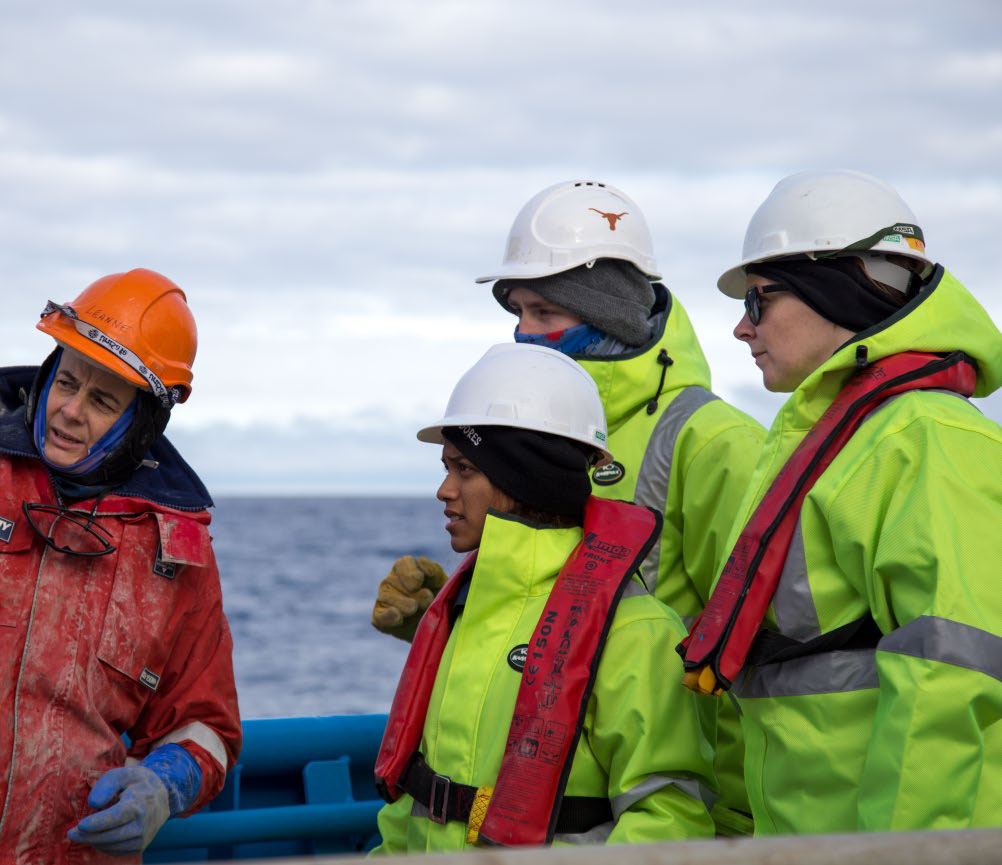
FOR FURTHER INFORMATION
Marine National Facility
t +61 3 6232 5596
e mnf@csiro.au
w mnf.csiro.au
Download the Annual Report 2016-17:
Marine National Facility
Annual Report 2016–17
About the Marine National Facility
The Marine National Facility (MNF) is a national blue-water research facility that has been funded by the Australian Government since 1984. The MNF consists of:
- the 94 metre blue-water research vessel Investigator;
- an extensive suite of fixed and modular state-of-the-art scientific equipment;
- an active repository of publicly available marine data and samples collected over 30 years; and
- a team of specialist staff to support the MNF and research vessel users.
The Marine National Facility is operated by CSIRO and overseen by an independent Steering Committee. It provides world-class blue-water research capability to the Australian scientific community and their international collaborators for work in Australia’s vast marine estate and beyond. Through merit based grants of sea time, research undertaken through the MNF benefits Australia by providing key information to government, industry and other stakeholders to support evidence-based decision-making towards sustainable development.
Australia has the third largest marine estate globally and the MNF is a keystone element of the nation’s research infrastructure to support the effective management and conservation of this territory. MNF research focuses on challenges such as environmental and fisheries management, geological resources, regional and global climate, coastal and offshore development and maritime heritage. To complement and increase utilisation of MNF capability, user funded voyage applications to undertake research of national benefit, are accepted and awarded sea time.
From the Chairperson

2016–17 saw Investigator deliver its first full year science schedule free of testing voyages required for ship commissioning. From time in Queensland waters studying the relationship between the Great Barrier Reef and climate processes, through to the study of the interaction of the Totten Glacier with the Southern Ocean, Investigator continues to deliver multidisciplinary projects across Australia’s vast ocean territory.
The assessment of applications for sea time is the strategic cornerstone of the MNF, with merit determined on three criteria: scientific excellence, national benefit and track record. The Scientific Advisory Committee (SAC) and the inaugural meeting of the newly created National Benefit Assessment Panel (NBAP) sat in November 2016 to consider single year applications for primary granted voyages for 2018–19. Demand was again strong for the available 180 days with 17 applications requesting a total of 544 days at sea. The approved schedule will see the vessel operating in the Southern Ocean for a large part of the year before travelling back to Western Australia to conduct surveys along Australia's International Indian Ocean Expedition line as part of the second International Indian Ocean Expedition (IIOE2: 2015–2020). As always, applications were of a very high standard, and I take the opportunity to thank all of our applicants for their submissions, the Scientific Advisory Committee (SAC) and National Benefit Assessment Panel (NBAP) for their rigorous review of them and the MNF staff for their oversight of the process and input into finalising the schedule of voyages.
The Steering Committee note, in particular, that the introduction of NBAP has produced greater transparency in assessing the potential national benefit and the path to research impact. The NBAP collectively provides an understanding of end-user needs including a strong working knowledge of Australian marine policy, management and industry priorities, and the associated research priorities.
Working towards achieving full year operations for the Investigator remains the highest priority for the Steering Committee, which continues its focus on seeking increased funding to support the vessel to deliver full capability.
The realisation of Investigator's research schedule over the past 12 months is the result of the commitment and hard work of the MNF Ships Group, technical staff and our ship users. I would like to take this opportunity to thank them for their continued efforts.
A special thanks is reserved for Mr Ron Plaschke, the MNF’s Director for the past five years. During his tenure, Ron oversaw a number of significant changes to the MNF including, most prominently, the successful development and introduction into service of research vessel Investigator, and the installation and commissioning of a broad, multi-million dollar suite of scientific equipment. Investigator’s entry into service has been a resounding success and is a testament to Ron’s expertise and leadership of the diverse team required to support the governance, management and operation of the MNF.
Dr Ian Poiner, Chairperson
MNF Steering Committee
From the Director

With two years of experience operating Investigator there was an internal review of the MNF Ships Group structure in October 2016 to ensure the Group had the required skills and organisational structure to address the challenges identified and lessons learnt. As a result, the MNF Operations Team added new roles to provide additional support in the areas of Health, Safety and Environment, and administration. The support brings additional capacity to successfully deliver voyages safely, and to assist meeting the increased operational requirements resulting from the new vessel's much more complex voyage schedule.
Investigator provides an impressive platform to deliver on the Science, Technology, Engineering and Mathematics (STEM) agenda which is a priority for the MNF, recognising the role graduates in these fields will play as future sea going marine scientists and mariners. To take advantage of this opportunity, the MNF successfully trialled an Educator-on-Board (EoB) program on a voyage to the remote Totten Glacier in East Antarctica in January 2017, providing a berth to high-school teacher Mr Stuart Gifford. Mr Gifford received hands-on experience working with the science team on-board and shared this with classrooms around Australia via live video crosses, giving Australian students the opportunity to experience in real time the research being delivered by Investigator.
Stuart also developed lesson plans for use by educators across the country in the delivery of STEM lessons to students. With the success of the trial, the MNF is developing a framework in collaboration with the CSIRO Education and Outreach team to deliver EoB more regularly. The program provides an opportunity to leverage additional educational benefits from voyages, and for educators to work with marine community users to optimise the use of the platform.
Ms Toni Moate
Director, National Collections and Marine Infrastructure

Health, Safety and Environment
Marine operations bring unique challenges in the management of health, safety and the environment. The MNF goal is zero harm and we are continuously seeking opportunities to improve systems, procedures and policies designed to ensure the safety of people on and around Investigator. People are at the heart of the MNF’s ability to deliver great science and innovation to our customers.
The new model of interdisciplinary science voyages spanning atmospheric, oceanographic, biological, geoscience and maritime heritage research and the increased capability to deliver longer voyages to more remote regions with an increased complement of crew and scientists has brought with it new challenges for the MNF with regard to health, safety and the environment. To meet these challenges, the MNF completed a detailed review of its health and safety systems in 2016–17 to ensure that all risks were identified and adequately mitigated. As a result of the review, the MNF introduced a range of new processes and controls to ensure that work conducted on board will cause no harm to people or the environment. In parallel, a number of initiatives were rolled out to MNF personnel to improve incident reporting and reinforce the responsibility of all personnel in the management of safety.
This heightened awareness and improved reporting mechanisms is likely to have led to an increase in reported incidents for the 2016–17 year against those of the previous reporting period. To ensure this is indeed the cause of the observed increase, a newly formed MNF HSE Committee will closely monitor HSE performance over the next 12 months.
No Lost Time Injuries were incurred during the 2016–17 financial year.
| 2015–16 | 2016–17 | |
|---|---|---|
| Lost Time Injury | 0 | 0 |
| Medical Treatment Case | 2 | 4 |
| First Aid Case | 6 | 22 |
| Illness | 2 | 5 |
| Total | 10 | 31 |

Continuous review and improvement initiatives for Investigator
Winch Inhibition Project
The MNF implemented a Winch Inhibition Project in 2017 to increase the safety for crew and participants involved in the operation of these high risk systems. The winch inhibition system requires that all winches are physically padlocked in the inhibited position by default, with a formal lock-out tag-out procedure followed to activate a winch for use. This initiative now provides an additional physical barrier to protect personnel from accidental winch use when working on scientific equipment.
Highlights
Infographic displaying RV Investigator highlights for the 2016-17 financial year. Detail includes: Bar graph comparing RV Investigator operations between 2015-16 and 2016-17.
2015-16
2016-17
Investigator Commissioning Sea trials (days)
13
11
Investigator Granted Voyages (days)
187
204
Investigator User Funded Voyages (days)
61
31
Total operational days including sea trials
261
235
Student participation (students)
25
51
Research schedule
An overview of the MNF voyage schedule for 2016–17 can be found on the MNF website. This includes Voyage Plans, Voyage Summaries and Scientific Highlight reports for each voyage.
The 2016–17 year commenced with the first of three transit voyages for the year as the vessel made its way back from Fiji to its home port of Hobart. A brief sea-trial out of Hobart was delivered to test and calibrate coring and dredging equipment in preparation for primary voyages later in the schedule. The vessel then transited to Sydney for the first of three primary voyages focused along the east coast of Australia to study the East Australia Current and Great Barrier Reef. Following this, the vessel travelled to Garden Island (NSW) for its first drydock since commissioning.
After systems trialing on the journey back to Hobart from Sydney, Investigator embarked on a voyage to the Totten Glacier in East Antarctica at the limit of the ship’s operating envelope. The trip to Antarctica was followed by a return to the Southern Ocean to maintain Integrated Marine Observing System moorings and two user funded voyages: the first being the second voyage for CSIRO Energy in a project with Chevron, and the second building the MNF's relationship with the Australian Hydrographic Service to map discreet areas in Bass Strait over 10 days.
The schedule concluded with a voyage led by Museums Victoria to sample the abyss along Australia's east coast including a number of Commonwealth Marine Reserves.
Voyage Spotlight – Delivering a world-first biodiversity survey of the abyss
The marine life at abyssal depths (>4000 m) along Australia’s eastern coastline is little understood. The lack of baseline data about species and their distribution makes it difficult to set policy and measure change. The increase of capability delivered by Investigator has, for the first time, provided the opportunity for researchers to sample at these depths.

In May and June 2017, Museums Victoria led a 31-day voyage on Investigator to conduct the first dedicated survey of marine life and the geophysical features of the abyss from Tasmania to Queensland. The voyage involved 38 scientists and support staff from seven countries and 14 institutions, including CSIRO, Museums Victoria, Australian Museum, Queensland Museum, Tasmanian Museum and Art Gallery, Deakin University and the University of Melbourne.
A broad range of research was undertaken during the voyage using a wide suite of the MNF scientific equipment, including deep water biodiversity sampling using nets, sleds and underwater cameras as well as processing, sampling and analysing specimens recovered using the ship’s on-board laboratory facilities.
During the voyage 42,747 specimens were collected, with over one third of the invertebrates thought to be new species. New vertebrate species will require description and be housed at museums and institutions across Australia, providing future material for research and study.
Highly detailed sea floor bathymetry surveys were also completed in seven marine reserves for the managing authority, Parks Australia. Better understanding of these habitats will assist Parks Australia to manage these important but little understood parts of our national marine assets.
The bathymetry voyage also surveyed marine debris and micro-plastics encountered in surface waters and from abyssal depths. This research is only possible due to the space and flexibility that Investigator offers. The information gathered from this project will contribute to better understandings of the impact of human activity on natural environments far removed from cities and homes.
Investigator demonstrates the value of the MNF as an international collaboration hub for knowledge exchange between scientists and end-users and, importantly, between scientists and the public. The significant public interest this voyage generated means that the data collected are already having an impact. Using the ship’s communication and broadcast capabilities, the science and discoveries were shared in the media during the voyage and reached a combined global audience in the millions, increasing awareness of life in our deepest oceans and how human activity can impact on it.
Communicating what we do
Effectively communicating what we do provides an opportunity for the Marine National Facility to demonstrate return on investment to the Australian public.
The MNF is committed to educating the Australian community about the research, education and training we deliver in order to demonstrate return on investment and ensure that decision makers at all levels – from individual citizens to government and industry – are well-informed and continue to support of the Facility into the future.
MNF communications have four strategic objectives:
Objective 1 – promote the MNF as a world-leading marine research capability available for Australian marine researchers
Objective 2 – raise awareness of the value and impact of the research, education and training delivered by the MNF
Objective 3 – effectively manage communication issues in order to protect and enhance the reputation of the MNF
Objective 4 – maintain brand visibility to ensure the MNF is identified as Australia’s blue-water research capability
To achieve these objectives, the MNF collaborates widely with the ship user community to support the regular delivery of communications that are relevant, accessible and appealing. MNF communicators focus on producing high-quality, multimedia communication products that are visually engaging and highlight the impact of the MNF and the need for full year operations for Investigator.
The MNF engages with target audiences through its stakeholder networks, and conventional and social media, as well as via a wide range of direct, digital and print platforms. The MNF also leverages the extensive reach of CSIRO communication channels, including the CSIROscope blog, to tell the story of the science, scientists and ship, and the impact delivered by every voyage.
Financial performance
Strong financial management is critical to ensuring the Marine National Facility remains viable, effective, and accountable for the expenditure of public funds.
| 2017 | 2016 | ||
|---|---|---|---|
| $'000 | $'000 | ||
| Revenue | |||
| External Funding |
891 |
18 |
|
| Internal Funding | 31,709 | 29,130 | |
| Total Revenue | 32,600 | 29,147 | |
| Expenditure | |||
| Salaries (including Pan-Deployments) | 5,841 | 4,572 | |
| Travel | 323 | 317 | |
| Other Operating | 18,942 | 17,004 | |
| Enterprise costs | 5,649 | 5,742 | |
| Total Expenditure | 30,755 | 27,634 | |
| Operating Result | 1,845 | 1,514 | |
| Capital | |||
| Capital Purchases (excluding FRV) | 712 | 706 | |
Acquisition of new science equipment and capabilities
Each year, the MNF undertakes a process to identify, prioritise and plan for the acquisition of major items of scientific equipment to support and increase the capability of the vessel for the benefit of users.
This year, the MNF spent $712,000 on science equipment, an overview of which can be reviewed on the MNF website.
Looking to the future
The Marine National Facility seeks to provide the best possible support to Australia’s marine science community and their collaborators. It also strives to increase engagement with future and early career researchers to grow Australia’s role as a global leader in a broad range of ocean science disciplines.
Having completed two years of operations since the commissioning year of RV Investigator further highlights the need for full year operations for the vessel. It is also timely to take a look at what we have learnt so far and apply those lessons to improving the way we support Australia’s marine scientists accessing and working on the vessel.
Planning and managing multidisciplinary research cruises is a complex endeavor and a significant time commitment for already busy scientists. The MNF is committed to continuous improvement in the way it helps researchers getting ready to go to sea and conducting their research on board as safely and successfully as possible. Over the next couple of years, we will be developing online tools to support cruise scheduling and simplify and streamline voyage planning and management.
Maintaining the scientific capabilities offered by the MNF and ensuring we keep up with evolving technologies is another challenge we are turning our attention to. We will be deepening our engagement with the broader scientific community and other organizations operating marine facilities within Australia and neighboring countries, which will strengthen our ability to meet new demands within a collaborative and coordinated framework.
The success of the Educator on Board (EoB) trial (IN2017_V01) and the upcoming second voyage of the Collaborative Australian Postgraduate Sea Training Alliance Network, or CAPSTAN, highlight the value of the Facility in education and training for the next generation of marine scientists.
FOR FURTHER INFORMATION
Marine National Facility
t +61 3 6232 5596
e mnf@csiro.au
w mnf.csiro.au

